Some plants thrive even in dry years, while others need wet years to really blossom. It's no surprise, then, that this year the University of California Cooperative Extension (UCCE) Fresno office has received several inquiries about potentially toxic plants and how to deal with them. Even if these species have always been present in the seed bank or on neighboring land, this year was a good year for toxic plants to grow large where previously they grew very small – or didn't grow at all.
Common plants that can cause livestock poisoning include annuals such as cockleburs, hairy fleabane, and yellow starthistle, and perennials like curly dock, larkspurs, and milkweeds. Annuals especially tend to respond vigorously to available soil moisture as they need to germinate a new generation each year from seed. Depending on how rapidly these plants develop roots, they may be able to produce a second generation (or more) even in the summer season. Populations of toxic plants may expand this year due to the good growing conditions.

Prevention
Maintaining healthy, diverse stands of forage to compete with toxic plants and to provide ample non-toxic options is the best prevention of plant poisonings in livestock. Grazing moderately is an important practice to maintain a healthy, diverse community of forage plants. Grazing too heavily can reduce desired species and allow toxic plants to become more common. Many toxic plants are not palatable, so they are avoided when other, desirable forage is available. However, animals may not be able to avoid harmful plants if a pasture is dominated by them. In those cases, it may be best to remove animals from that pasture and/or provide them with an alternate feed source until the toxic plant is reduced.
When managing fields for hay production, minimizing the population of toxic plants is critical. Animals can't be selective around different plant parts in hay bales or flakes, and many toxic plants are harmful even in very small quantities.
Risk and monitoring
At this time in the summer, many common toxic plants in California are highly visible in contrast to dry, golden annual grasses. Monitoring could be as simple as driving or walking along fencelines and especially checking high-impact areas such as corrals, holding pens, water troughs, and mineral licks. Riparian areas are also important monitoring areas, such as the banks of creeks and streams. These can be key host sites for toxic plants, and animals like to spend time in those cooler areas during the summer. Animal exposure to toxic plants may be higher when the annual forages have dried up and lush green plants may be enticing.
When monitoring key areas on your property, take photos and/or samples of unfamiliar plants. You can send pictures or bring samples to your local UCCE office (find yours here) for assistance in identifying the plants and any necessary management strategies. If you bring a sample, please be sure to bag the whole plant, including the roots if possible. If you take pictures, try to have a photo that shows the full plant, as well close-ups of the leaf shape, flowers or fruits/seeds, and any other unique features such as spines or hairs.
You can also use the online weed ID tool at the Weed RIC website to narrow down possible plants yourself. Be sure to change the Search Location to California!
Management resources
To learn more about plants that are toxic to livestock, you can download the UC ANR publication, Livestock-poisoning Plants of California, for free b y clicking HERE. This resource includes useful photos of common harmful plants as well as detailed information about the health impacts of different plants on cattle, sheep, goats, and horses.
Once you have a confirmed plant ID, you can find out what management practices can control the species you have. Weed reports from the UC ANR publication Weed Control in Natural Areas in the Western United States are one of the best resources that describe all possible control methods, and how well they can work. You can download specific weed reports here or purchase the full book from your local UCCE office, or online here.
If you have livestock with signs of plant toxicity, contact your veterinarian for support. If livestock have died, you can contact the CAHFS lab nearest you to get an estimate for a necropsy or other toxicology tests.
